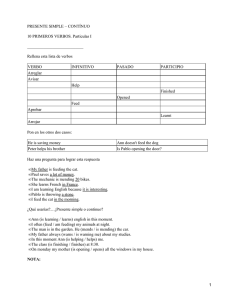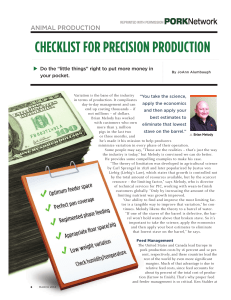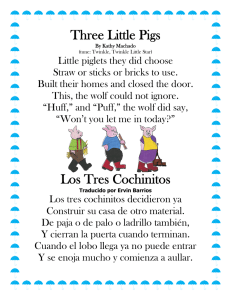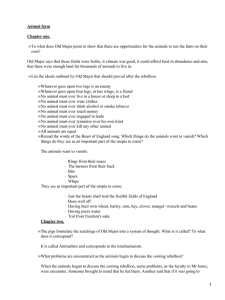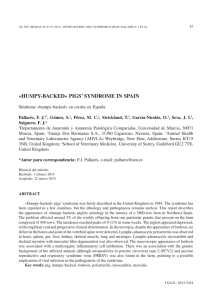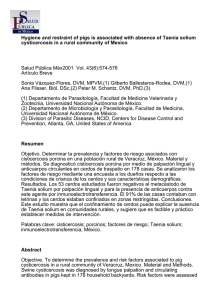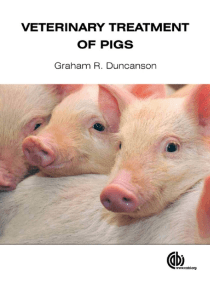C:\Documents and Settings\All U
Anuncio
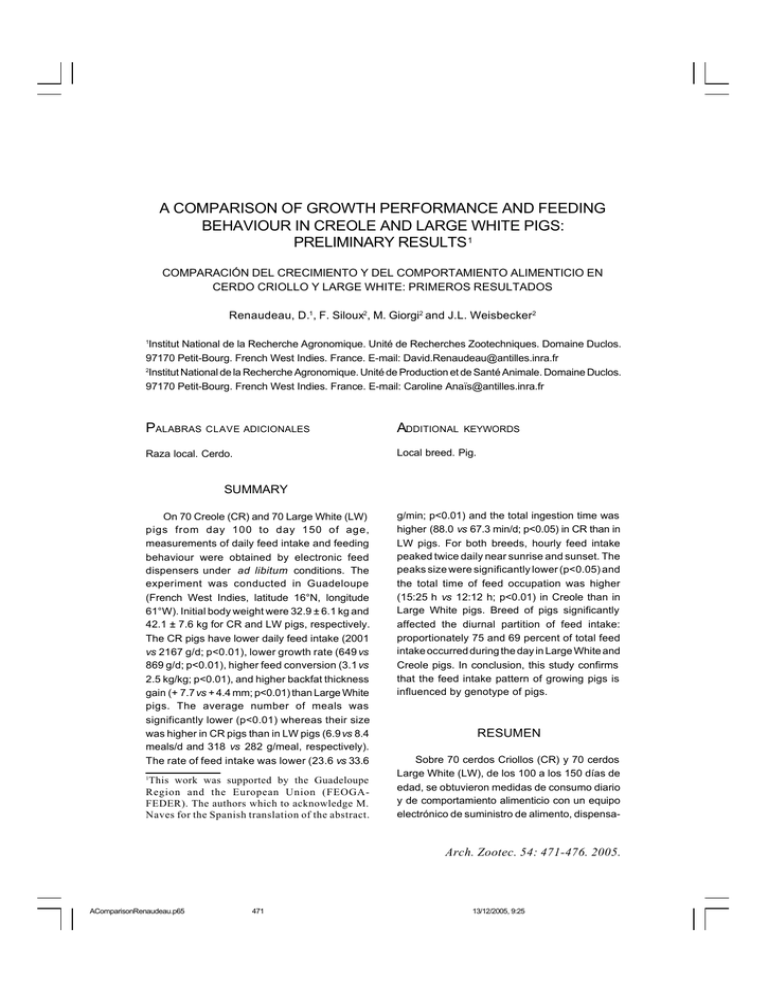
A COMPARISON OF GROWTH PERFORMANCE AND FEEDING BEHAVIOUR IN CREOLE AND LARGE WHITE PIGS: PRELIMINARY RESULTS 1 COMPARACIÓN DEL CRECIMIENTO Y DEL COMPORTAMIENTO ALIMENTICIO EN CERDO CRIOLLO Y LARGE WHITE: PRIMEROS RESULTADOS Renaudeau, D.1, F. Siloux2, M. Giorgi2 and J.L. Weisbecker2 1 Institut National de la Recherche Agronomique. Unité de Recherches Zootechniques. Domaine Duclos. 97170 Petit-Bourg. French West Indies. France. E-mail: [email protected] 2 Institut National de la Recherche Agronomique. Unité de Production et de Santé Animale. Domaine Duclos. 97170 Petit-Bourg. French West Indies. France. E-mail: Caroline Anaï[email protected] PALABRAS CLAVE ADICIONALES ADDITIONAL Raza local. Cerdo. Local breed. Pig. KEYWORDS SUMMARY On 70 Creole (CR) and 70 Large White (LW) pigs from day 100 to day 150 of age, measurements of daily feed intake and feeding behaviour were obtained by electronic feed dispensers under ad libitum conditions. The experiment was conducted in Guadeloupe (French West Indies, latitude 16°N, longitude 61°W). Initial body weight were 32.9 ± 6.1 kg and 42.1 ± 7.6 kg for CR and LW pigs, respectively. The CR pigs have lower daily feed intake (2001 vs 2167 g/d; p<0.01), lower growth rate (649 vs 869 g/d; p<0.01), higher feed conversion (3.1 vs 2.5 kg/kg; p<0.01), and higher backfat thickness gain (+ 7.7 vs + 4.4 mm; p<0.01) than Large White pigs. The average number of meals was significantly lower (p<0.01) whereas their size was higher in CR pigs than in LW pigs (6.9 vs 8.4 meals/d and 318 vs 282 g/meal, respectively). The rate of feed intake was lower (23.6 vs 33.6 1 This work was supported by the Guadeloupe Region and the European Union (FEOGAFEDER). The authors which to acknowledge M. Naves for the Spanish translation of the abstract. g/min; p<0.01) and the total ingestion time was higher (88.0 vs 67.3 min/d; p<0.05) in CR than in LW pigs. For both breeds, hourly feed intake peaked twice daily near sunrise and sunset. The peaks size were significantly lower (p<0.05) and the total time of feed occupation was higher (15:25 h vs 12:12 h; p<0.01) in Creole than in Large White pigs. Breed of pigs significantly affected the diurnal partition of feed intake: proportionately 75 and 69 percent of total feed intake occurred during the day in Large White and Creole pigs. In conclusion, this study confirms that the feed intake pattern of growing pigs is influenced by genotype of pigs. RESUMEN Sobre 70 cerdos Criollos (CR) y 70 cerdos Large White (LW), de los 100 a los 150 días de edad, se obtuvieron medidas de consumo diario y de comportamiento alimenticio con un equipo electrónico de suministro de alimento, dispensa- Arch. Zootec. 54: 471-476. 2005. AComparisonRenaudeau.p65 471 13/12/2005, 9:25 RENAUDEAU, SILOUX, GIORGI AND WEISBECKER do ad libitum. El experimento se realizó en Guadalupe (Antillas Francesas). El peso vivo al inicio fue 32,9 ± 6,1 kg y 42,1 ± 7,6 kg para CR y LW, respectivamente. Los cerdos CR tienen menor consumo diario (2001 vs 2167 g/d, p<0,01), más bajo crecimiento (649 vs 869 g/d, p< 0,01), más elevada conversión alimenticia (3,1 vs 2,5 kg/kg, p<0,01), y más alta ganancia de espesor de grasa de la espalda (+7,7 vs +4.4 mm, p<0,01) que los LW. El promedio de comidas fue significativamente más bajo (p<0,01), y su tamaño mayor para los cerdos CR que los LW (6,9 vs 8,4 comidas y 318 vs 282 g/comida, respectivamente). El ritmo de consumo fue menor (23,6 vs 33,6 g/min, p<0,01) y el tiempo total de ingestión fue mayor (88,0 vs 67,3 min/d, p<0,05) en cerdos CR que en LW. Para ambas razas, el consumo por hora se elevó, cerca del amanecer y del anochecer. El tamaño al pico fue significativamente más bajo (p<0,05) y el tiempo total de consumo fue más alto (15:25 h vs 12:12h, p<0,01) en CR que en LW. La raza afectó significativamente el consumo: 75 p.100 y 69 p.100 del consumo total diario ocurrió de día en LW y CR respectivamente. Se confirma que la distribución del consumo diario está influida por el genotipo de los cerdos. INTRODUCTION In Guadeloupe (F.W.I. 16°lat. N., 61°Long. W.), the Creole (CR) pigs represent approximately 20 to 30 p.100 of the total pig's population and are locally appreciated for the better fresh meat quality. However, CR pigs are characterised by a reduced growth rate, a poor muscle development, and a higher propensity to fat deposition which limits their utilisation in semiintensive production system (Rinaldo et al., 2000). The growth performance and chemical composition of gain depends on the daily nutrients intake and the digestive and metabolic utilisation by the animal. However, there is little information on the voluntary feed intake and the feeding behaviour in CR pigs. The aim of this study was to evaluate differences in growth performance, and feeding behaviour between CR and LW pigs using an electronic feed intake recording equipment. MATERIALS AND METHODS A total of 140 pigs were used in three replicates of 40 pigs and one replicate of 20 pigs to evaluate the effect of genotype (CR vs LW) on growth performance and feeding patterns during 7 weeks. Pigs were moved in an open-front fattening unit around 90 days of age. In the replicate of 40 pigs, animals were allocated to four pens of ten pigs per pen on the basis of breed and sex (female vs castrated male). In the replicate of 20 pigs, only 2 pens were used; each pen contained an equal number of pigs from each sex originating from the same breed. The pens were equipped with an Acema 48 feed dispenser and animals had 24-h access to feed and water. Feed was presented as pellets and contained 9.7 MJ. kg-1 net energy and 157 g. kg-1 crude protein. The experiment started at 110 days of age; the average body weights (BW) at the beginning were 32.9 and 42.0 kg for CR and LW pigs, respectively. Ambient temperature, relative humidity, and photoperiod followed those of the outdoor conditions. Pigs were weighed and backfat thickness was measured ultrasonically at 50 mm from the midline of the last- Archivos de zootecnia vol. 54, núm. 206-207, p. 472. AComparisonRenaudeau.p65 472 13/12/2005, 9:25 GROWTH AND FEEDING BEHAVIOUR IN CREOLE AND LARGE WHITE PIGS rib level at the beginning and the end of the experiment. All feed equipments were calibrated at the start of the study using a 1-kg test weight. The feed dispensers were equipped with a protective crate in front of the feed trough that allowed only one pig to access to the feeder at any time. After each visit to the feed station, the identity of the animal (ear tag transponder), the feeder entry and exit times and the amount of feed consumed were recorded and stored in the central monitoring equipment memory. Successive feeder visits were grouped into meals using the so-called meal criterion. This was defined as the maximum length of the within-meal interval; visits separated by interval longer than the meal criterion were considered as a different meal. The meal criterion of 2 min calculated by Labroue et al. (1999) using the same feed dispenser equipment was adopted at present study. Data on daily feed intake traits were used to calculate the number of meal per day, feed consumption (g/day and g/meal), ingestion time (min/day and min/meal) defined as the total duration of all the visits during the day or the meal, and the rate of feed intake (g/min) defined as the daily feed intake divided by the daily ingestion time. The effects of breed, sex, replicate, and the breed-sex interaction on growth performance and feeding behaviour components were tested through an analysis of variance (GLM procedure, SAS, 1990). For each pig, hourly values of feed consumption were calculated; these data were analysed through a repeated measurement ANOVA (SAS, 1990) by comparison of hourly value to a reference value (i.e., mean hourly consumption value between 00:00 and 03:00). The effect of breed on the kinetics of feed ingestion was analysed from generation of contrasts between adjacent hourly values. RESULTS As no interaction breed-sex was found for all criteria studied, only the effects of breed are presented in the text. Least square means for genotype effects on growth performance were presented in table I. The CR have lower average daily feed intake (ADFI) than LW pigs (2001 vs 2167 g/d; p<0.01). Expressed per kilogram of metabolic body weight, the ADFI was higher for CR pigs (112 vs 100 g. d-1. kg 0.75g/d; p<0.01). However, the average daily gain (649 vs 869 g/d; p<0.01) was lower and feed conversion ratio and backfat thickness gain were significantly higher in CR (3.1 vs 2.5 kg/kg and + 7.7 vs + 4.4 mm, respectively). Feeding behaviour parameters were significantly affected by the genotype (table I). The rate of feed intake was lower for CR compared to LW (23.6 vs 33.6 g/min; p<0.01). Consequently, total ingestion time was greater for CR than LW (88.0 vs 67.3 min/d; p<0.01). LW compared to CR pigs made more frequent visits to the feeder (42.1 vs 26.0; p<0.05). However, according to the high coefficient of variation (i.e., C.V.= 66 percent), there was a considerable variation for both breeds between individual animals in the frequency of feeder visits. The daily number of meals was lower (p<0.01) Archivos de zootecnia vol. 54, núm. 206-207, p. 473. AComparisonRenaudeau.p65 473 13/12/2005, 9:25 RENAUDEAU, SILOUX, GIORGI AND WEISBECKER Table I. Effect of breed on growth performance in growing pigs from day 100 to day 150 (adjusted means). (Efecto de la raza sobre el crecimiento de los cerdos entre 100 y 150 días de edad (medias ajustadas)). Number of animals Growing performance Initial BW, kg Final BW, kg Initial backfat thickness, mm Final backfat thickness, mm Daily feed intake, g. d-1 Daily feed intake, g. d-1. kg0.75 Daily BW gain, g.d-1 Feed conversion, kg.kg-1 gain Feeding behavior Number of visits Number of meals Meal size, g Ingestion time, min Ingestion time, min/meal Rate of feed intake, g.min-1 RSDa Statistical analysis b 42.0 79.8 5.8 10.2 2167 100 869 2.5 4.4 7.1 1.3 2.1 331 13 115 0.3 B**, R** B**, R** B**, R** B**, S**, R** B**, S**, R** B**, S**, R** B**, S* B**, S**, R** 42.1 8.4 282 67.3 8.4 33.6 22.9 1.9 89 13.7 2.9 4.9 B**, S**, R* B**, R** B*, S**, R** B**, S** B**, S**, R** B**, R* Creole Large White 70 70 32.9 60.9 9.4 17.1 2001 112 649 3.1 26.0 6.9 318 88.0 13.5 23.6 a Residual standard error; bANOVA with breed (B), sex (S), replicate (R), and breed x sex interaction (B x S) as main effect. *p<0.05, **p<0.01. whereas their size was higher (p<0.05) in CR than in LW. The ingestion time per meal was higher in CR pigs in connection with the reduction of the rate of feed intake. From the comparison of hourly feed intake to basal value (i.e., between 00:00 and 03:00 h) or variation between successive hours, the hourly feed intake peaked twice a day for both seasons(figure 1). During the diurnal period, the hourly feed intakes were significantly higher (p<0.05) in LW than in CR between 06:00 and 09:00 h, and 14:00 and 16:00 h. In contrast, feed intake was higher (p < 0.05) in CR at 01:00, 02:00, and 19:00 h. Moreover, the proportion of feed intake during the diurnal period was higher for LW compared to CR (75 vs 69 percent; p<0.05). DISCUSSION According to the previous results obtained in our station (Canope et Raynaud 1981, Deprès et al., 1992, and Renaudeau et al., unpublished results), the growth performances of CR were lower than those of exotics breeds reared in tropical conditions. Similar results were reported when Iberian (Serra et al., 1998) or Meischan pigs (Edwards et al., 1991) were Archivos de zootecnia vol. 54, núm. 206-207, p. 474. AComparisonRenaudeau.p65 474 13/12/2005, 9:25 GROWTH AND FEEDING BEHAVIOUR IN CREOLE AND LARGE WHITE PIGS Feed intake (g/h) compared to conventional breeds. As observed in Meishan pigs, the propensity to high fat deposition in CR is related to their reduced growth rate or protein deposition. Little information is available on the feeding behaviour in CR. The reduction of ADFI in CR was associated with a reduction of number of meals. This decrease of meal frequency was counterbalanced by an increase of meal size; it was also associated with a longer ingestion time per meal. These effects of pigs genotype on meal characteristics in the present study are in agreement with the results of Quiniou et al. (1999) based on individually Meischan and LW studied over the same BW range. According to these authors, the higher propensity to fat deposition could explain the reduced number of meals. However, such a difference could be related to early maturity of the CR. At an average BW of 63 kg, the rate of feed intake 200 180 160 140 120 100 80 60 40 20 0 of LW was intermediate between values reported over the same BW range by Nielsen et al. (1995) (26.9 g/ min) and Labroue et al. (1999) (38.1 g/ min). Moreover, Quiniou et al. (1999) suggested that the rate of feed intake increases with the increase of BW. In consequence, the reduced rate of feed intake measured in CR could be related to their smaller average BW. According to the reduction of the ADFI and the rate of feed intake, total ingestion time increased in CR. For both genotypes, the pattern of daily feed intake can be characterised by two peaks of feeding activity, one in the morning (i.e., similar to the sunrise) and the other one in late afternoon (i.e., before the beginning of the night). Our results suggest that the feeding activity of growing pigs is mainly driven by light intensity changes. However, the first peak can also be attributed to the beginning of the work in the station. Breed also affected the Creole Large White Light 0 4 8 12 16 20 24 Time of the day (h) Figure 1 . Effect of the breed and the time of the day on the average food intake per hour. (Efecto de la raza y de la hora del día sobre el consumo promedio por hora. Archivos de zootecnia vol. 54, núm. 206-207, p. 475. AComparisonRenaudeau.p65 475 13/12/2005, 9:25 RENAUDEAU, SILOUX, GIORGI AND WEISBECKER feeding pattern. The reduction of the peaks size and the increase of the daily average of feeder occupation in CR (+ 03:14 h) were connected to their lower rate of feed intake. These changes in feeding behaviour of CR pigs could be attributed to an increase of individual social competition for feeder access. Early morning and late evening feeding activity may have been performed by CR pigs that were unsuccessful at competing to feeder access during the light period (Young and Lawrence, 1994). The results obtained here confirm the reduced growth performance in CR pigs compared to an exotic breed and indicate that feeding behaviour can be affected by genotype. The change in nycthemeral pattern of feed intake observed in CR can be attributed to their reduced rate of feed intake that would increase time of feeder occupation and competition to feeder access. REFERENCES Canope, I. and Y. Raynaud. 1981. Etude comparative des performances de reproduction, d'engraissement et de carcasse des porcs Créoles et large White en Guadeloupe. Journées des Recherches Porcines en France, 13: 307-316. Deprès, E., F. Tamisier, M. Naves and D. Rinaldo. 1992. Comparaison de porcs Créole et Large White pour les performances de croissance et la qualité de la viande en fonction de l'âge de l'abattage. Journées des Recherches Porcines en France, 24: 17-24. Edwards, S.A., V.R. Fowler, E. Berges, A.G. Taylor and C.S. Haley. 1991. Comparison of Meishan and white pigs for voluntary intake and digestibility of high fibre diets. Animal Production, 52: 600 (abstract). Labroue, F., R. Gueblez, M.C. Meunier-Salaun and P. Sellier. 1999. Feed intake behaviour of group-housed Pietrain and Large White growing pigs. Annales de Zootechnie, 48: 247-261. Nielsen, B.L., A.B. Lawrence and C.T. Whittemore. 1995. Effect of group size on feeding behaviour, social behaviour, and performance of growing pigs using single-space feeders. Livestock Production Science, 44: 73-85. Quiniou, N., S. Dubois, Y. le Cozler, J.F. Bernier and J. Noblet. 1999. Effect of growth potential (body weight and breed/castration combination) on the feeding behaviour of individually kept growing pigs. Livestock Production Science, 61: 13-22. Rinaldo, D., I. Canope and R. Christon. 2000. El cerdo Criollo de Guadalupe: una revisión sobre la reproducción, el comportamiento en crecimiento y la calidad de la carne en relación a las condiciones dietéticas. V Congreso Iberoamericano de Razas Autóctonas y Criollas, La Habana, Cuba. 1: 250-254. SAS. 1990. SAS/STAT User's Guide (version 6 4th Ed.). SAS Inst. Inc. cary, NC. Serra, X., F. Gil, M. Perez-Enciso, M.A. Oliver, J.M. Vazquez, M. Gispert, I. Diaz, F. Moreno, R. Latorre and J. L. Noguera. 1998. A comparison of carcass, meat quality and histochemical characteristics of Iberian (Guadyerbas line) and Landrace pigs. Livestock Production Science, 56: 215-223. Young, R.J. and A.B. Lawrence. 1994. Feeding behaviour of pigs in groups monitored by a computerized feeding system. Animal Production, 58: 145-152. Archivos de zootecnia vol. 54, núm. 206-207, p. 476. AComparisonRenaudeau.p65 476 13/12/2005, 9:25
